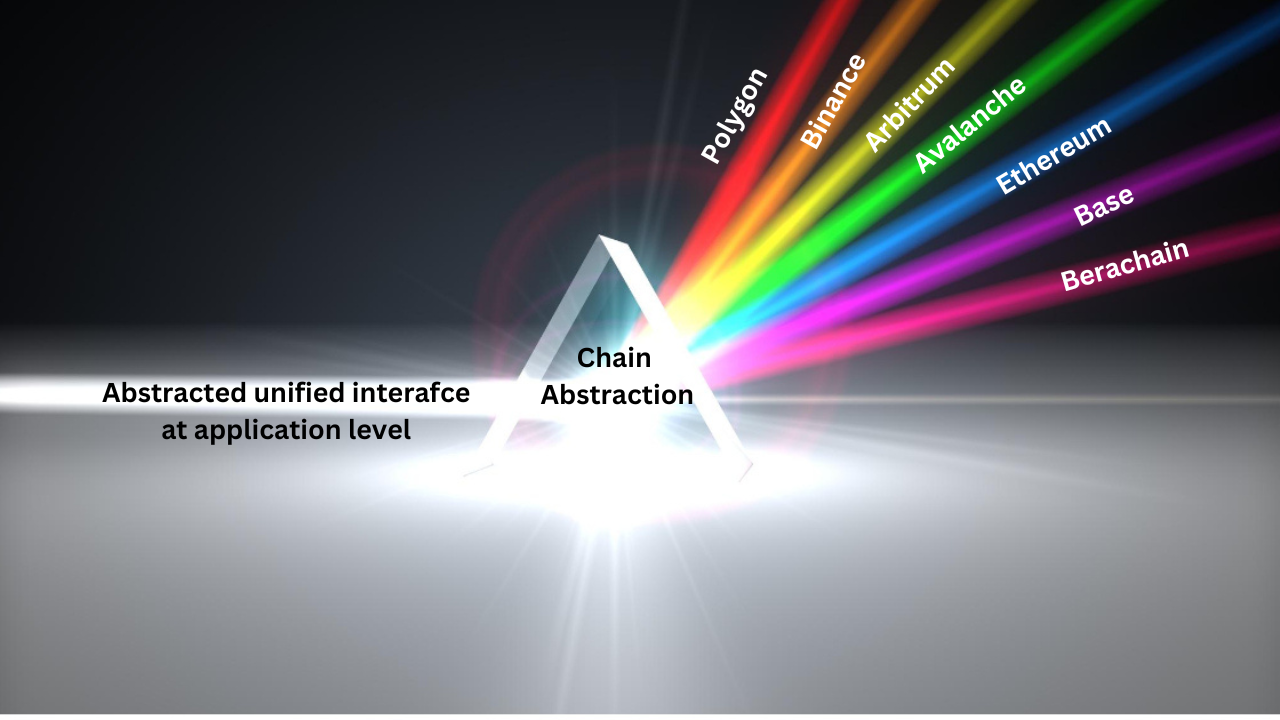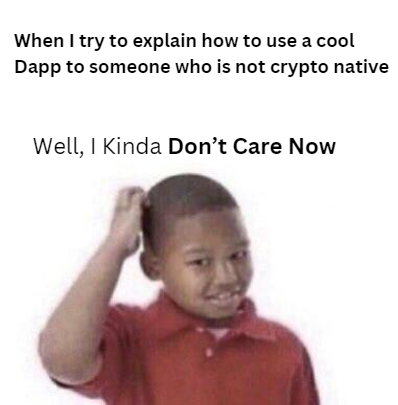Chain abstraction: A unified interface abstracting underlying blockchains
 Rushikesh Jadhav
Rushikesh Jadhav
In a Web2 world, we rarely need to care about what specific infrastructure or network an application is running on. Whether it’s a VPN, WAN, or some internal network, the user is blissfully unaware of the complexities behind the scenes. But in Web3, we still hear things like, “We are live on Berachain,” or “We’re super bullish on Avax, so our dApp is only on Avax.” This focus on individual chains creates a fragmented ecosystem, making it harder for users to navigate across various blockchain networks seamlessly.
Ecosystems being aggressive to onboard more applications or specific offerings from a particular chain has led applications to choose a particular chain. Applications existing on different chains have caused various issues like the following
Fragmented liquidity
Fragmented user base
Friction onboarding users
While applications must build on the chain that suits their needs, users should be abstracted away from the complexities of the underlying technology. There is no reason for a user to know what network/chain the application is sitting on.
These complications are major barriers to mass web3 adoption.

What Chain Abstraction Can Bring In?
Chain abstraction fundamentally transforms how users and developers interact with blockchain ecosystems by smoothing out many of the current pain points and limitations. Here’s what it brings to the table:
Interoperability
One of the most significant advantages is seamless interoperability across different blockchains. Rather than being confined to a single chain, chain abstraction allows applications to communicate and operate across multiple networks. This opens up a new level of cross-chain functionality that was previously hard to achieve.
Abstraction
Users don’t need to concern themselves with what blockchain they are interacting with. Whether it’s Ethereum, Berachain, or Avalanche, the underlying chain becomes irrelevant to the user experience. They can focus on the application itself, not the infrastructure it’s built on.
Abstraction Over Gas Fees: No more worrying about which token you need to pay gas fees with. Chain abstraction can handle this behind the scenes, ensuring that users aren’t scrambling to swap tokens or hold the right balance on every chain. In some cases, this might even mean abstracting gas fees completely, offering users a gas-free experience.
Abstraction Over the Underlying Chain: With chain abstraction, users won’t even know what blockchain their transaction is running on. The process of executing smart contracts and transfers will be completely hidden from them, just like how users don’t think about server locations when they access Web2 applications. The underlying chain becomes invisible, removing another layer of complexity.
Better UX
Chain abstraction enhances user experience by removing unnecessary friction. Users no longer have to manually switch networks or manage multiple wallets just to interact with a dApp. Instead, everything works fluidly in the background, providing a smooth, uninterrupted experience.
No Wallet Switching: The days of users hopping between wallets to match the correct blockchain for an application are over. Chain abstraction eliminates the need for wallet switching, letting users interact with multiple chains from a single wallet seamlessly. This significantly simplifies onboarding and user flow.
Unified Balances Across Chains: Instead of fragmented token balances spread across multiple chains and wallets, chain abstraction can provide a unified view. Users will see a single balance across all chains, making it easier to manage assets without worrying about what tokens are sitting on which blockchain.
Better Liquidity Management
With chain abstraction, applications can tap into liquidity pools across multiple chains simultaneously. This means better liquidity management, as dApps no longer need to rely on a single network’s liquidity. The ability to aggregate liquidity across chains leads to more efficient markets.
- Unified Liquidity: Instead of fragmented liquidity locked up on different blockchains, chain abstraction enables a unified liquidity pool. This allows users and applications to access a larger pool of liquidity without the need for bridging assets between chains manually, helping to alleviate fragmented liquidity issues across ecosystems.
By removing these barriers, chain abstraction brings us closer to a future where blockchain technology becomes more user-friendly, unlocking the full potential of decentralized applications without the current friction or complexity.
How does chain abstraction work?
Chain abstraction is the solution to this problem. It hides the complexities of individual blockchains from both developers and users, offering a unified interface to interact with multiple chains. Here's how it works:
User Interaction: Users engage with decentralized applications (dApps) as they normally would, without needing to know which blockchain they are interacting with.
Request Translation: When a user initiates an action, like a token transfer, the chain abstraction layer converts this request into a format that can be understood by the destination blockchain. This eliminates the need for users to worry about chain-specific transaction formats or mechanics.
Message Relay: The translated request is handed off to a relayer network, a decentralized network responsible for securely routing messages between different blockchains. The relayer network ensures that the request reaches the correct destination.
Transaction Execution: Once the request is delivered to the target blockchain, the transaction is executed as though it were natively initiated from that blockchain.
Confirmation Relay: After the transaction is confirmed, the relayer network sends back a confirmation to the chain abstraction layer, ensuring that the user's action has been completed successfully.
UI Update: The chain abstraction layer updates the dApp’s interface to reflect the completed transaction, without the user needing to know anything about which blockchain it was processed on.
To invoke transactions either intents or cross-chain protocols are used.
In simple words, Intents lets users specify what they want to achieve (e.g., transfer assets) without dealing with the details. Agents (aka solvers) handle these requests, providing fast and efficient service. This makes user interactions with on-chain apps simpler and more intuitive. [Learn more about intents]
On the other hand, Cross-chain protocols use off-chain Oracle networks to invoke a transaction on any chain. e.g. An application operating on multiple chains but using a specific chain for a specific purpose. In this case, transactions meant for a specific chain are routed to that chain using off-chain oracle networks. [Learn about cross-chain protocols here]
How Can One Enable Chain Abstraction in Their Application?
There are several SDKs and protocols that enable chain abstraction by simplifying cross-chain communication and transaction management. These solutions vary in their approaches, but all aim to abstract away the complexities of dealing with multiple blockchains. Below are a few notable protocols and networks that can help you implement chain abstraction in your application:
NEAR Protocol -L1 chain that natively offers chain abstraction.
Particle Network - L1 chain unifying all chains through universal accounts.
Agoric - An orchestration SDK that unifies liquidity and protocols from multiple chains.
Connext Protocol - A modular protocol for securely passing funds and data between chains.
Each of these protocols offers unique features and underlying mechanisms for achieving chain abstraction, enabling developers to build applications that are scalable, secure, and easy to use across multiple blockchains. Depending on your needs, you can choose the protocol that best fits your application’s goals.
Conclusion
In the current landscape of Web3, the notion of being tied to a specific blockchain creates unnecessary friction for both users and developers. Chain abstraction is the key to unlocking a more seamless and intuitive experience, where the underlying complexities of different blockchains are hidden from users, just like we don’t think about the infrastructure of a Web2 application. By abstracting the underlying chains, gas fees, and fragmented liquidity, chain abstraction offers better interoperability, a smoother user experience, and more efficient liquidity management.
Protocols like NEAR, Particle Network, Agoric, and Connext are already paving the way for applications to achieve chain abstraction, enabling developers to build cross-chain dApps that are scalable and easy to use. As blockchain technology continues to evolve, chain abstraction will play a critical role in onboarding the next wave of users by making decentralized applications as user-friendly as their Web2 counterparts.
The future of Web3 lies in breaking down the barriers between chains, and chain abstraction is the bridge that will connect these fragmented ecosystems, delivering a unified, frictionless experience for all.
Subscribe to my newsletter
Read articles from Rushikesh Jadhav directly inside your inbox. Subscribe to the newsletter, and don't miss out.
Written by

Rushikesh Jadhav
Rushikesh Jadhav
Innovative Smart Contract & Backend Developer building cross-chain interoperable smart contracts and Dapps. With over a year of hands-on experience in smart contract and backend development, I’m passionate about transforming blockchain technology into powerful, user-friendly solutions. My expertise lies in developing cross-chain decentralized applications that streamline interactions and enhance user experiences. From designing upgradeable smart contracts to optimizing token strategies and developing dynamic algorithms, I thrive on solving complex challenges and delivering impactful results. My work has led to significant improvements in user returns and project rankings, reflecting my commitment to innovation and excellence. I’m all about making blockchain technology more accessible and effective. Let’s connect and see how we can push the boundaries of blockchain together! 🚀